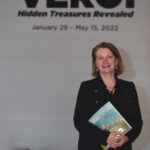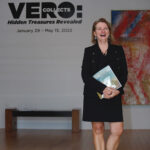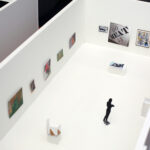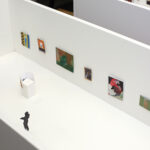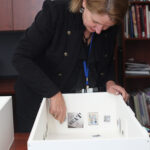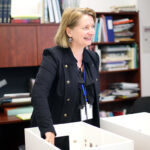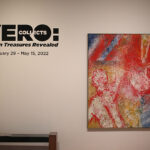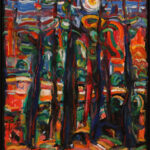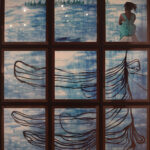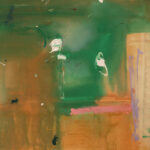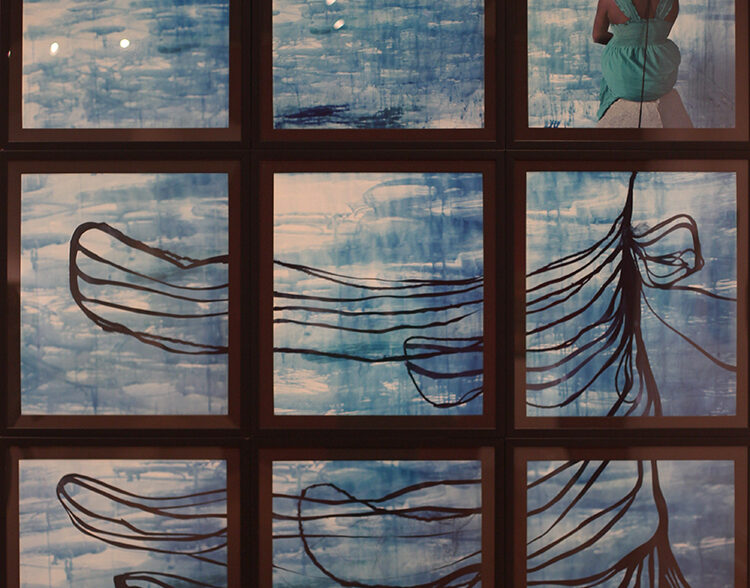
If you think that the “Vero Collects” exhibition now on display at the Vero Beach Museum of Art is only about European Old Masters, with a few French and American Impressionists thrown in as a nod to modernity, you would, happily, be wrong.
In fact, the first artwork you see upon entering the museum’s Holmes Gallery is Grace Hartigan’s abstract “Rockefeller Center” of 1990. Composed of the primary colors plus white, the painting’s composition is an orchestrated explosion of drops and spatters that coalesce into pieces of the human figure. On loan from the collection of Jim and Elizabeth Berges, the painting hangs on the show’s front-facing white title wall.
Even if it were not 6.5 feet tall by 6 feet wide, you would still understand that the plum placement of Hartigan’s painting clearly announces that the VBMA is to be seen as an up-to-date institution that values American art of the recent past.
In 1945 Hartigan was a young mother from New Jersey, newly arrived in New York City with painter Isaac Lane Muse. The latter was a modernist, with whom Hartigan had recently begun the study of painting. Introduced by Muse, Hartigan soon met Abstract Expressionists Jackson Pollack and Lee Krasner, those exemplars of a pioneering generation. The then-new drip paintings of Pollack and the encouragement of Krasner had a profound influence on Hartigan’s development as a painter.
At the tail end of the 1940s, Hartigan’s work was selected for the “Talent 1950” exhibition at the Kootz Gallery. Co-curated by Clement Greenberg and Meyer Shapiro, Hartigan’s work was introduced alongside that of Elaine de Kooning, Franz Kline, Larry Rivers, Helen Frankenthaler, and many other new artists, to a sophisticated, art-buying audience eager to call dibs on the next big name.
From that show emerged the Second Generation of Abstract Expressionism, artists who carried their elders’ persistent flag into the 21st century.
Like Hartigan, art history has deemed Helen Frankenthaler a member of the Second Generation. Frankenthaler is represented in the current show by “Green Domain” of 1982, on loan from the collection of Madeline and George Long. Frankenthaler was a proponent of what Clement Greenberg called “Color Field” painting.
That label says it all. Color Field painting is known for outpourings of color on canvases large enough to fill the beholder’s field of vision. In 1952, Frankenthaler and Pollock, working independently, stained unprimed cotton duck canvas with thinned liquid pigments and introduced a new painting technique to the world.
Visiting Frankenthaler’s studio, Color Field painters Morris Louis and Kenneth Noland were so impressed by her technique that they absorbed staining in their own work.
In her earliest stain paintings, Frankenthaler applied thinned oil colors to her canvas. As acrylic paint developed through the 1950s, from latex outdoor house paint into water-based artists’ paints, Frankenthaler and other painters began to favor acrylic paint’s water-soluble, elastic and low-fume properties. Through their experimentation with acrylics, artists spurred manufacturers to develop ever more acrylic colors.
Frankenthaler’s “Green Domain” is a product of this advanced technology. In the 1980s Frankenthaler was using acrylic paint to which sparkling mica power had been added. Up close, a subtle sparkle can be seen in the gorgeous green veil that descends over two-thirds of her picture. Upon this surface, Frankenthaler placed silver acrylic paint in blobs and pats that float like satellites above a misty, terrestrial atmosphere.
While Hartigan and Frankenthaler are two of the New York art stars represented in the show, let us not forget the momentous artists of contemporary art’s second city, Washington, D.C. In Vero Collects, “Evening Glow,” a 2006 painting by David Driskell, reminds us that you don’t have to live in New York to be a guiding star.
The painting is on loan from the Nancy and Russell Brewer Collection, “who have almost exclusively collected African-American artists,” says VBMA curator Anke Van Wagenberg.
The foreground of “Evening Glow” is fortified with a row of tall tree trunks that expend from the top of the canvas to nearly its bottom, where they are sunk into a juicy mass of thick paint strokes. Behind them, slivers of a luscious landscape burst through the bar-like trees.
Says Van Wagenberg, “This is a rare painting by Driskell in encaustic, where pigment is mixed with liquid hot wax and applied with brush or spatula to his canvas. The result is very brilliant colors.”
Unlike most of his contemporaries, Driskell was also an art historian and teacher. His teaching career began in 1955 at Howard University, and concluded at the University of Maryland in College Park, where he retired as Distinguished Professor of Art. In 2001, the University of Maryland established the David C. Driskell Center to honor not only Driskell’s academic prowess, but also his role in preserving and enriching African-American art and culture.
Painting is not the only contemporary art you will find in Vero Collects. Photography makes quite a splash here too, in María Magdalena Campos-Pons’ “Dreaming of an Island” of 2008.
On loan from the collection of Pat and Peter M. Thompson, the artwork is composed of 12 individually framed Polaroid photographs arranged in three rows of three, packed cheek to jowl. Overall, the work measures a tad over 7 feet high and 6 feet wide.
Those photographs are large format, 24-x-20-inch unique prints. In the top left print, a girl-woman (Campos-Pons herself) sits with her back to us on a fragment of stone before a watercolor expanse of blue that continues through the other eight panels. The horizon that the woman gazes upon is broken by the trees of a distant island.
Her hair is braided; one long, skinny braid plummets down her back to the water below. There the braid, entwined by yards of black ribbon, swells like a drift net on the sea. Perhaps those filaments, bobbing in that fertile element, are conducting energy back to their human source.
“Dreaming of an Island” is a striking image with an undercurrent of loneliness. For political reasons that affected both her and the conceptual art she practices, Cuban-born Campos-Pons moved to the United States in 1991. She lived in Boston for years before accepting a teaching position at Vanderbilt University in Nashville.
Water, and references to the native Cuban religion of Santeria and the women who practice it, often appear in Campos-Pons’ work. Those subjects point to her declared desire to retain, through her art, her roots in Cuban culture.
Speaking of photographically captured images, a digital video by the Swiss artists Peter Fischli and David Weiss is bound to mesmerize some museum-goers. On loan from the collection of Pamela and Richard Kramlich, “The Way Things Go” was created during the years 1985 to 1987.
“This is great fun,” says Van Wagenberg.
The video shows a Rube Goldberg-esque set-up that relies on chemical reactions and gravity, more than gravity plus mechanical actions, to make it go. It takes about 30 minutes for a combination of substances to roll down chutes and slides to reach their destination, with a lot of foam, fire, tire-rolling and balloon-popping in between.
Says Van Wagenberg, “This piece became very famous. Fischli and Weiss created this whole sequence in an old factory building in Switzerland and then filmed its action in one take. This video was in the Venice Biennale, and several other biennales in the world.”
She reveals that “The Way it Goes” was the first video artwork the Kramlichs collected.
“Then they collected, more, and now they are one of the biggest video collectors in America,” she says.
Hmmm. Wouldn’t it be nice to see a video like this gifted to the collection?
Says Van Wagenberg, firmly: “The goal is to show the variety of collection activities in Vero Beach. That is the intention of the show.”
Photos by Kaila Jones

